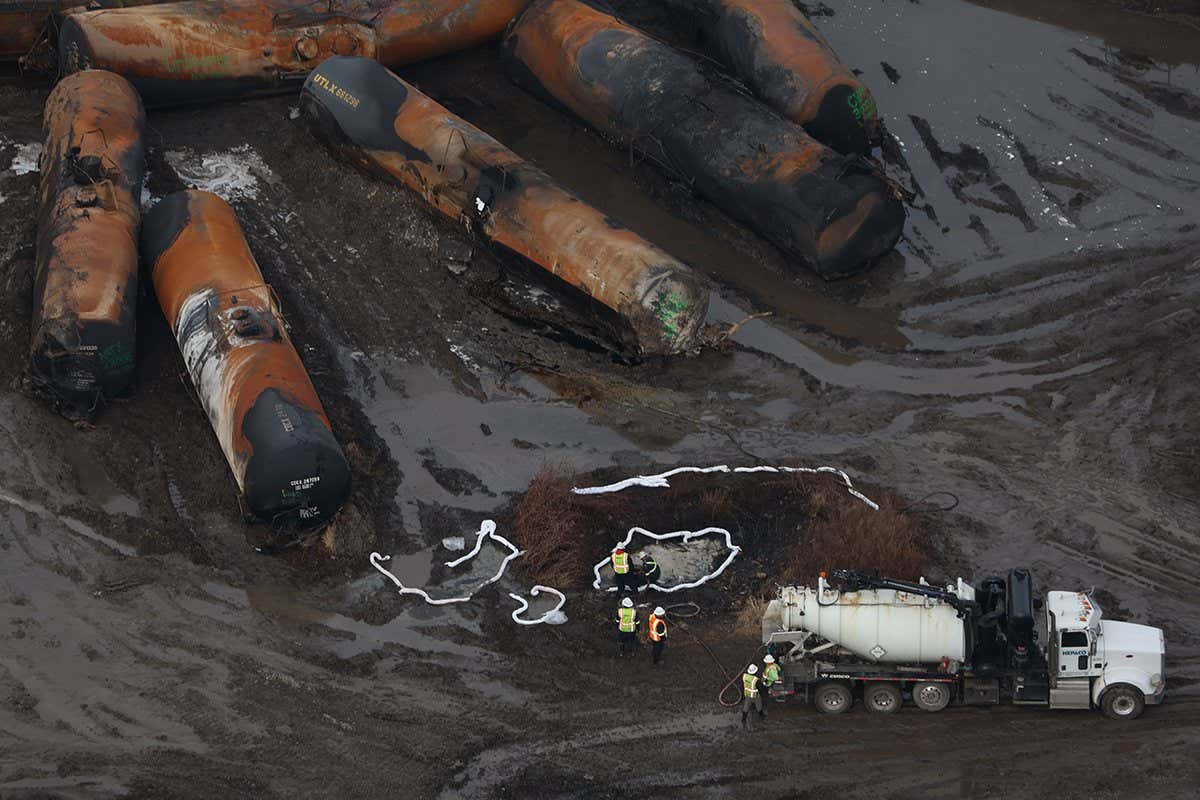Lingering Effects: Toxic Chemicals From Ohio Train Derailment Remain In Buildings

Table of Contents
Pathways of Chemical Contamination in Buildings
The toxic plume from the Ohio train derailment didn't simply dissipate. These chemicals found their way into buildings through various pathways, leaving a trail of potential health hazards.
Air Contamination
Airborne chemicals spread rapidly following the derailment, infiltrating homes and businesses within the affected area.
- Lingering Chemicals: Vinyl chloride, a known carcinogen, is particularly concerning due to its volatility and ability to persist in the air. Other chemicals, including butyl acrylate and ethylene glycol monobutyl ether, also pose significant respiratory and health risks.
- Duration of Contamination: Airborne contamination can persist for extended periods, depending on factors like weather patterns, building ventilation, and the chemical's properties. This prolonged exposure increases the risk of long-term health issues.
- Health Effects: Inhaling these chemicals can lead to a range of acute and chronic respiratory problems, including coughing, shortness of breath, asthma exacerbation, and potentially, more serious lung diseases. Regular air quality testing is crucial in assessing the levels of these contaminants. Effective remediation may involve air scrubbing systems or enhanced ventilation to reduce the concentration of harmful airborne chemicals.
Water Contamination
Groundwater and surface water contamination pose another significant threat. Chemicals can seep into the water supply, affecting buildings through plumbing systems and potential leaks.
- Sources of Contamination: Leaking tanks, contaminated soil, and runoff from the derailment site can all contribute to water contamination.
- Water Testing: Thorough testing is essential to determine the extent of contamination in both drinking water and groundwater supplies. Comprehensive water quality analysis should be conducted, including testing for specific chemicals released during the derailment.
- Health Effects: Consuming contaminated water can lead to various health problems, ranging from gastrointestinal issues to more severe organ damage. Long-term exposure to contaminated water can have lasting consequences on overall health.
Soil Contamination
The penetration of chemicals into the soil presents a long-term challenge. This soil contamination can affect building foundations and lead to indoor air pollution through vapor intrusion.
- Impact on Building Integrity: Soil contamination can weaken building foundations, leading to structural damage over time. The long-term stability of affected buildings might be compromised.
- Vapor Intrusion: Volatile organic compounds (VOCs) from contaminated soil can migrate into buildings through cracks in the foundation or other pathways, leading to indoor air pollution.
- Soil Remediation: Cleaning up contaminated soil is a complex and costly process, often involving excavation and specialized remediation techniques. Bioremediation, using microorganisms to break down pollutants, or phytoremediation, employing plants to absorb contaminants, are also potential solutions.
Health Risks Associated with Lingering Chemicals
Exposure to the toxic chemicals released from the Ohio train derailment presents serious and potentially long-lasting health risks.
Respiratory Problems
The inhalation of these chemicals is a primary concern, leading to a range of respiratory issues.
- Specific Respiratory Issues: Asthma, bronchitis, and other chronic obstructive pulmonary diseases (COPD) can be exacerbated or triggered by exposure to these chemicals. Pneumonia and other serious lung infections are also potential outcomes.
- Symptoms: Symptoms can include coughing, wheezing, shortness of breath, chest tightness, and persistent respiratory irritation.
- Long-term Implications: Chronic exposure to these chemicals can lead to irreversible lung damage and significantly reduced lung function.
Neurological Effects
Certain chemicals released during the derailment have neurotoxic properties, potentially causing neurological damage.
- Types of Neurological Damage: Exposure may lead to cognitive impairment, memory loss, difficulty concentrating, and even more serious neurological disorders.
- Symptoms: Symptoms can vary but may include headaches, dizziness, confusion, numbness, tingling, and changes in mood or behavior.
- Long-term Effects: The long-term effects of neurotoxic exposure can be devastating, potentially impacting quality of life and overall health significantly.
Other Health Concerns
Beyond respiratory and neurological problems, exposure to these chemicals can cause other health issues.
- Skin Irritation: Direct contact with contaminated surfaces can cause skin irritation, rashes, and burns.
- Reproductive Issues: Some of the chemicals involved are suspected endocrine disruptors, potentially affecting reproductive health.
- Medical Attention: Anyone experiencing symptoms after exposure should seek immediate medical attention for proper diagnosis and treatment.
Cleanup Efforts and Remediation Strategies
Addressing the lingering effects of the Ohio train derailment requires a multi-faceted approach to cleaning and remediating the affected areas.
Air Quality Remediation
Effective remediation strategies are crucial for mitigating the risks of airborne contaminants.
- Air Scrubbing: Specialized air filtration systems can remove harmful chemicals from the air.
- Ventilation Improvements: Improving building ventilation can help reduce indoor air pollution by diluting the concentration of harmful chemicals.
- Air Purifiers: High-efficiency particulate air (HEPA) filters and activated carbon filters can help remove particles and certain gases from the air.
Water Treatment and Remediation
Ensuring access to safe drinking water is paramount.
- Water Filtration Systems: Specialized filtration systems can remove contaminants from drinking water sources.
- Testing Protocols: Regular water testing is essential to monitor the effectiveness of treatment methods and to ensure the safety of the water supply.
- Long-term Monitoring: Continuous monitoring is crucial to prevent future contamination events.
Soil Remediation Techniques
Cleaning up contaminated soil is a complex and resource-intensive process.
- Excavation: In some cases, contaminated soil needs to be removed and disposed of properly.
- Bioremediation: This method utilizes microorganisms to break down pollutants in the soil.
- Phytoremediation: This technique uses plants to absorb and remove contaminants from the soil.
- Challenges and Costs: Soil remediation is often costly and time-consuming, presenting significant challenges in terms of logistics and resource allocation.
Conclusion
The lingering effects of the toxic chemicals released from the Ohio train derailment continue to pose significant risks to the health and safety of residents in affected areas. The persistent contamination of buildings highlights the urgent need for comprehensive cleanup and remediation efforts. Addressing air, water, and soil contamination is crucial to mitigate the long-term health risks associated with exposure to these hazardous substances, including respiratory problems, neurological damage, and other health concerns. Staying informed about the ongoing situation is paramount. If you live in or near the affected areas and suspect contamination in your building from the Ohio train derailment's toxic chemicals, seek professional assistance immediately for building inspections and remediation. Consult your local health authorities and environmental agencies for up-to-date information and guidance.

Featured Posts
-
 Tampa Bey Vyigryvaet Seriyu U Floridy Blagodarya Kucherovu
May 16, 2025
Tampa Bey Vyigryvaet Seriyu U Floridy Blagodarya Kucherovu
May 16, 2025 -
 Ataka Rf Na Ukrainu Posledstviya Massirovannogo Udara Bolee Chem 200 Raketami I Dronami
May 16, 2025
Ataka Rf Na Ukrainu Posledstviya Massirovannogo Udara Bolee Chem 200 Raketami I Dronami
May 16, 2025 -
 Celtics In Orlando Game 3 Playoffs Preview
May 16, 2025
Celtics In Orlando Game 3 Playoffs Preview
May 16, 2025 -
 Ancelotti Vs Tebas Clash Over Real Madrids Fixture Congestion
May 16, 2025
Ancelotti Vs Tebas Clash Over Real Madrids Fixture Congestion
May 16, 2025 -
 The Untold Story Of Tom Cruises Response To Suri Cruises Arrival
May 16, 2025
The Untold Story Of Tom Cruises Response To Suri Cruises Arrival
May 16, 2025
